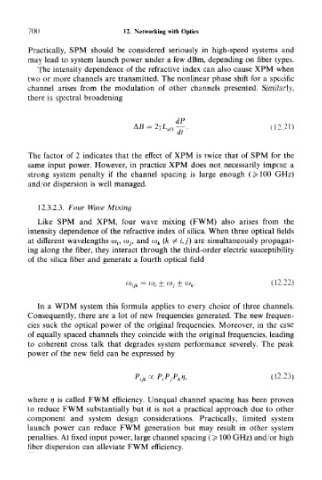Page 716 - Introduction to Information Optics
P. 716
700 12. Networking with Optics
Practically, SPM should be considered seriously in high-speed systems and
may lead to system launch power under a few dBm, depending on fiber types.
The intensity dependence of the refractive index can also cause XPM when
two or more channels are transmitted. The nonlinear phase shift for a specific
channel arises from the modulation of other channels presented. Similarly,
there is spectral broadening
dP
—. (12.21)
The factor of 2 indicates that the effect of XPM is twice that of SPM for the
same input power. However, in practice XPM does not necessarily impose a
strong system penalty if the channel spacing is large enough (^100 GHz)
and/or dispersion is well managed.
12.3.2.3. Four Wave Mixing
Like SPM and XPM, four wave mixing (FWM) also arises from the
intensity dependence of the refractive index of silica. When three optical fields
at different wavelengths o^, co,-, and co k (k ^ ij) are simultaneously propagat-
ing along the fiber, they interact through the third-order electric susceptibility
of the silica fiber and generate a fourth optical field
w ijk =- Mi ± ojj + oj k. (12.22)
In a WDM system this formula applies to every choice of three channels.
Consequently, there are a lot of new frequencies generated. The new frequen-
cies suck the optical power of the original frequencies. Moreover, in the case
of equally spaced channels they coincide with the original frequencies, leading
to coherent cross talk that degrades system performance severely. The peak
power of the new field can be expressed by
(12.23)
where Y\ is called FWM efficiency. Unequal channel spacing has been proven
to reduce FWM substantially but it is not a practical approach due to other
component and system design considerations. Practically, limited system
launch power can reduce FWM generation but may result in other system
penalties. At fixed input power, large channel spacing 0 100 GHz) and/or high
fiber dispersion can alleviate FWM efficiency.

